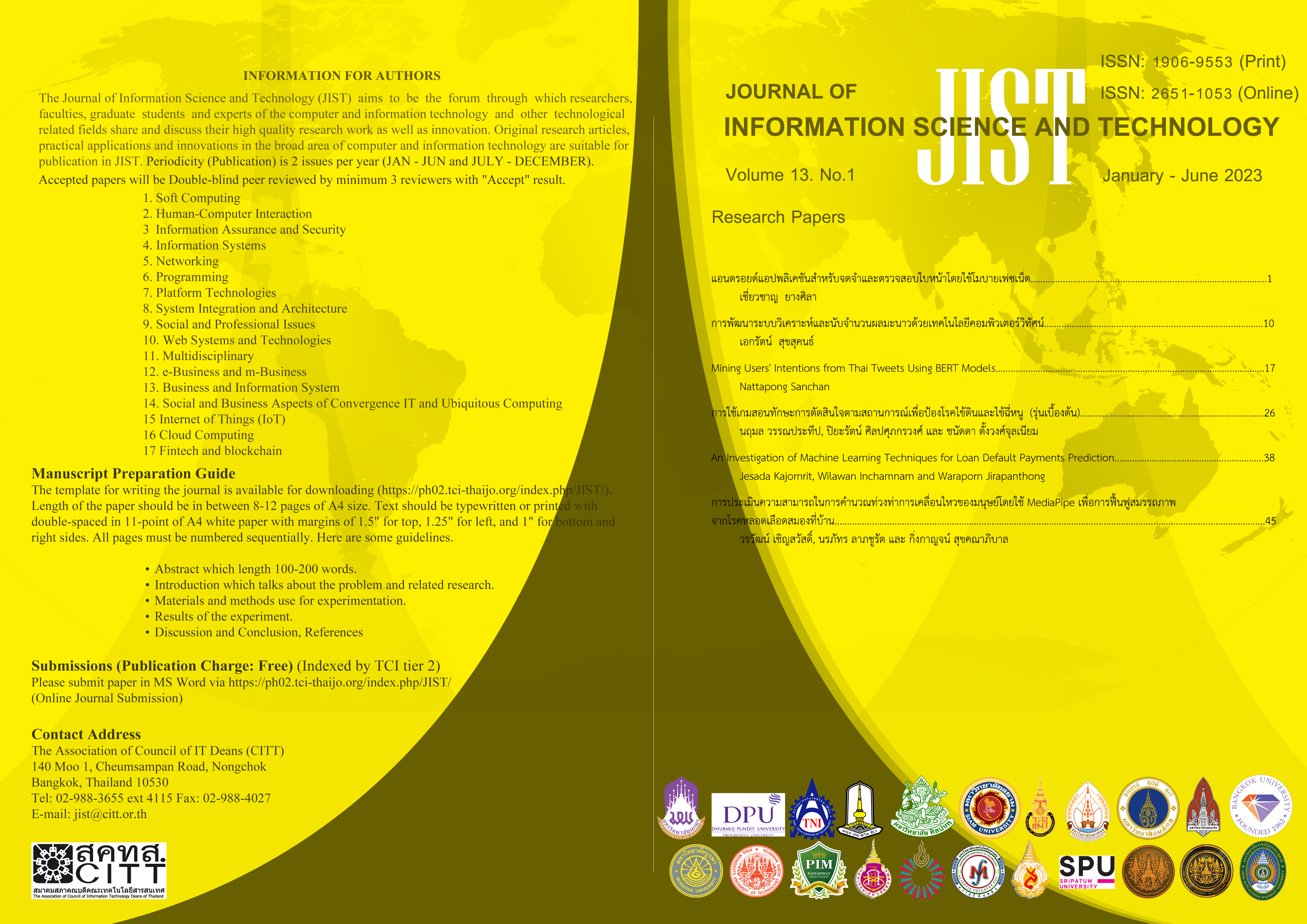Mining Users' Intentions from Thai Tweets Using BERT Models
Main Article Content
Abstract
In this paper, we explore the mining of users’ intentions in text. We viewed that being able to identify the intentions of users expressed in textual data provides us to specifically know aims and what users want to do. In the experiment, we collected tweets, constructed a Thai intention corpus, and performed a binary classification task on the corpus. We investigated the intent classification results derived through the application of 3 different Bidirectional Encoder Representations from Transformers (BERT), Word Embedding, and Bag of Words models. The results revealed that BERT Based EN-TH Cased model outperforms other models in both classification and processing time aspects. It achieves the F1 Score of 0.81 and performs the classification task faster than other BERT models up to 15%.
Article Details
This work is licensed under a Creative Commons Attribution-NonCommercial-NoDerivatives 4.0 International License.
I/we certify that I/we have participated sufficiently in the intellectual content, conception and design of this work or the analysis and interpretation of the data (when applicable), as well as the writing of the manuscript, to take public responsibility for it and have agreed to have my/our name listed as a contributor. I/we believe the manuscript represents valid work. Neither this manuscript nor one with substantially similar content under my/our authorship has been published or is being considered for publication elsewhere, except as described in the covering letter. I/we certify that all the data collected during the study is presented in this manuscript and no data from the study has been or will be published separately. I/we attest that, if requested by the editors, I/we will provide the data/information or will cooperate fully in obtaining and providing the data/information on which the manuscript is based, for examination by the editors or their assignees. Financial interests, direct or indirect, that exist or may be perceived to exist for individual contributors in connection with the content of this paper have been disclosed in the cover letter. Sources of outside support of the project are named in the cover letter.
I/We hereby transfer(s), assign(s), or otherwise convey(s) all copyright ownership, including any and all rights incidental thereto, exclusively to the Journal, in the event that such work is published by the Journal. The Journal shall own the work, including 1) copyright; 2) the right to grant permission to republish the article in whole or in part, with or without fee; 3) the right to produce preprints or reprints and translate into languages other than English for sale or free distribution; and 4) the right to republish the work in a collection of articles in any other mechanical or electronic format.
We give the rights to the corresponding author to make necessary changes as per the request of the journal, do the rest of the correspondence on our behalf and he/she will act as the guarantor for the manuscript on our behalf.
All persons who have made substantial contributions to the work reported in the manuscript, but who are not contributors, are named in the Acknowledgment and have given me/us their written permission to be named. If I/we do not include an Acknowledgment that means I/we have not received substantial contributions from non-contributors and no contributor has been omitted.
References
Gupta, V. Pant, S. Kumar, & P. K. Bansal, “Bank Loan Prediction System using Machine Learning,” 2020 9th International Conference System Modeling and Advancement in Research Trends (SMART), 4, 12, 2020, pp. 423 – 426.
Schank RC, Abelson RP. Scripts, plans, goals, and understanding. Hillsdale, New Jersey: Lawrence Erlbaum Associates; 1997.
Mckevitt P, “Analysing coherence of intention in natural language dialogue,” Ph.D. thesis. Exeter: University of Exeter; 1991.
Hollerit, B., Kröll, M., & Strohmaier, M, “Towards linking buyers and sellers: detecting commercial intent on Twitter,” In Proceedings of the 22nd International Conference on World Wide Web. 2023, pp. 629-632.
Wang J, Cong G, Zhao XW, Li X, “Mining User Intents in Twitter: A Semi-Supervised Approach to Inferring Intent Categories for Tweets, ” The Twenty-Ninth AAAI Conference on Artificial Intelligence. ’05, 2015, pp.339-345.



